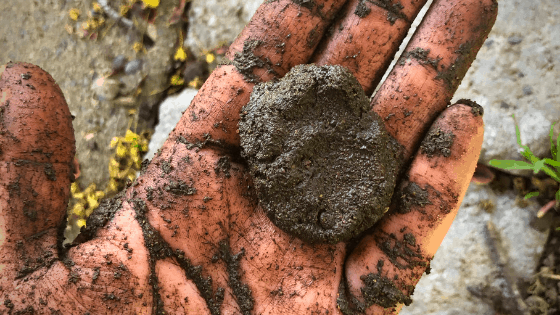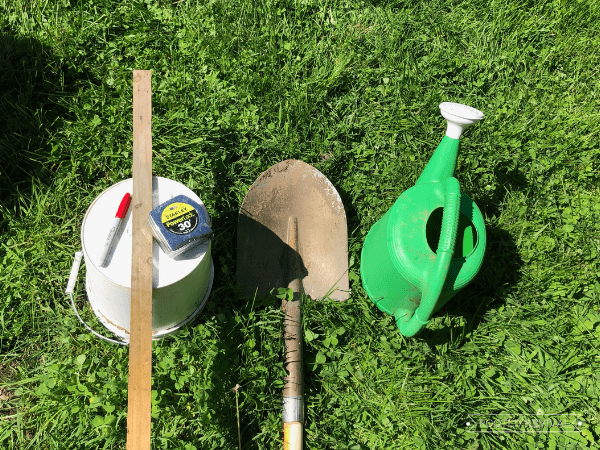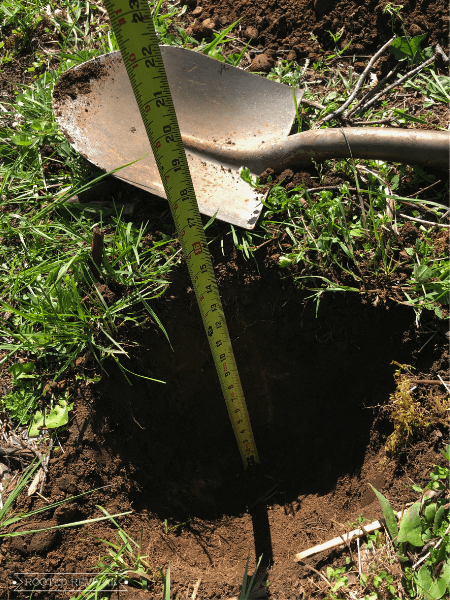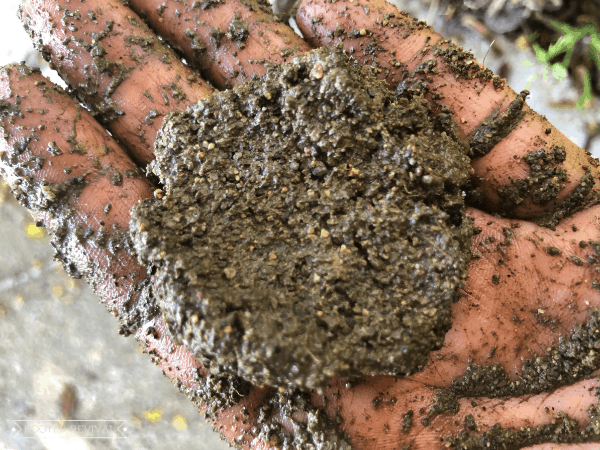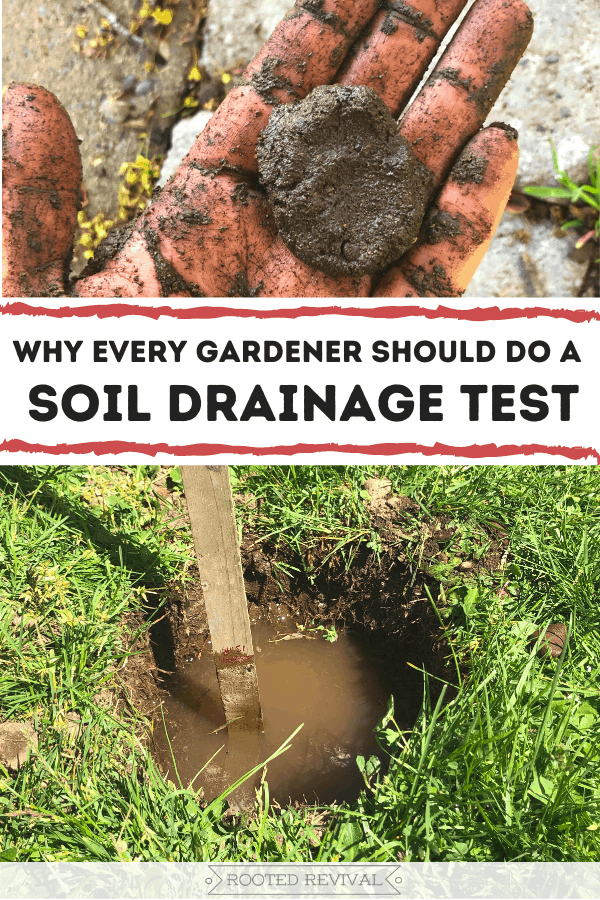Did you know that soil drainage can directly effect how successful your garden is? Luckily, it’s easy to learn more about your soil by doing an easy at-home soil drainage test!
Are you tired of guessing how much and how often to water your plants?
Knowing how and when to water your plants is an often overlooked aspect of gardening. Yet, every year, I hear people lamenting about rotted plants that they barely watered. Or plants that dried up and died despite being watered regularly. And, hey, I’ve been there and done that too!
Let me tell you a secret: it’s not just how much you water. It’s also what kind of soil you have!
For instance, heavy clay soils capture rainfall and water and hold it. While sandy soils let water drain quickly.
Conveniently, nature (as usual) knows what she’s doing. Here’s an example: When we lived in the high desert of Southwest Idaho, we had heavy clay soils. But this area also only gets about 12 inches of rain a year! So the soil is designed to hold the moisture as long as possible, allowing the plants to use it before it’s absorbed.
Alternatively, we now live near Seattle in one of the rainiest regions of the US. We receive about 55 inches of rain a year! And, not surprisingly, the soils here are sandy, rocky and gravelly which allows the water to drain quickly. The soil doesn’t need to hold onto water for long, because there is most likely more coming soon!
How soil type effects your watering schedule:
Now, clearly nature knows what she’s doing. However, the problems come when things get out of whack. For instance, when unprecedented rains happen in a traditionally dry area, the soil isn’t able to absorb it and flooding occurs.
And, not surprisingly, we humans can also cause issues! For instance, if we are watering our plants too much or not enough. Luckily, a simple test can help us better understand our soil profile, how to mimic nature, and how to water properly for our soil type.
A soil drainage test can help!
There are a lot of great ways to learn more about your unique soil. And, there are several tests that you can do from home without any special supplies! The Mason Jar test is a great way to find out more about the texture and components of your soil, and I highly recommend it.
But, one of the fastest ways to test your soil is with a soil drainage test (also called a percolation test). It’s so easy to do, too! All you need is a shovel, a marker, a ruler/tape measure, a stick and some water!
Seriously, that’s it!
A soil drainage test will help you better understand your soil structure based on how fast water drains through it. It will also help you better understand how to water your vegetation and plants!
How to Test Soil Drainage:
You will need:
- A shovel or trowel
- A stick or stake (about 2 foot tall)
- Measuring tape or ruler
- Marker or pen
- Watering can or access to a hose
Perform the Soil Drainage Test:
- To perform a soil percolation test, begin by picking out a spot where you would like to test your soil. Ensure the area is free of rodent holes and tunnels.
- Use a clean shovel to dig a hole in the soil at least one foot deep and one foot wide.

- Clean out as much loose dirt from the hole as possible so that the hole has nice clean walls.
- Use a watering bucket or hose to fill the hole with water. Let the water fully absorb into the soil. Fully saturating the soil before testing will increase the accuracy of this test.
- Place a stake or stick into the soil at the bottom of the hole so that it stands up straight out of the hole.
- Fill the hole with water again, until the hole is nearly full. Use a marker to make a line on the stake to represent the top of the water line.

- Set a timer to check the water every 5-15 minutes (if you have fast draining soil) up to every hour (if you have slow draining soil). Make a new mark on the stake to represent the new water level at each time increment.
- Observe how long it takes the water to completely drain and measure to your original water line mark. Then, measure the distance between your incremental marks on the stake. This will tell you how fast your soil is draining.
- Calculate how many inches of water per hour your soil drained.

- Optional: Learn how to do an at home soil texture test to get even more valuable information about your soil texture!
Understanding your results:
Results between 1-3 inches per hour:
Congratulations – you have great soil texture! The ideal soil drainage amount is about 2 inches per hour. However, drainage anywhere between 1-3 inches per hour is generally just fine for most vegetation. This ideal soil texture is called “loam”.
Tips for loamy soils: Loam is ideal for most plants as it holds water, but not for too long. A consistent and regular watering schedule is ideal for loamy soils. However, certain plants may have different watering requirements. For these plants, you can amend the soil directly around them as needed when you plant them.
Results less than 1 inch per hour:
If you soil drainage results are less than 1 inch per hour, your soil likely is high in clay. Clay soils are made up of extremely small particles that become tightly compacted, reducing air and water flow.
Tips for clay soils: Clay soils can easily become water-logged as they have a hard time absorbing water. Adding organic matter and mulch will help to increase porosity (air pockets), break up compaction, and better absorb and drain water.
Ensure sure that you aren’t over-watering since clay soils hold water and drain slowly. Allow the soil time to dry in between waterings. Always double check soil moisture levels by sticking your finger 2-3 inches into the soil. Clay soils may appear dry on top but can still be moist below the surface.
Results greater than 3 inches per hour:
If your soil drainage results are greater than 3 inches per hour, your soil is likely high in sand and gravel components. This type of soil tends to drain so quickly that it can be hard for plants to fully absorb the moisture, making it important to water more often.
Tips for sandy soils: Adding organic matter will help increase soil humus which can help trap and hold moisture like a sponge. Water frequently but in shorter time increments, as water is easily wasted since it can’t be absorbed or held in the soil.
My Soil Drainage Test Results:
I have performed this test both at our homestead in Southwest Idaho and, most recently, at our new homestead here in Western Washington. As I mentioned earlier, we used to have very heavy clay soil in Idaho. But, here in Western Washington, we now have gravelly and sandy soil, which is very fast draining. I knew the soil would drain quickly, but I was shocked by how fast it drained when I performed the test!
I tested three different sites on our new homestead, following the procedure above. Here are the results:
- Site 1 (Garden Space): Drained 10 inches in 40-45 minutes
- Site 2 (Yard/Future Orchard Space): Drained 9 inches in 20 minutes
- Site 3 (Pasture): Drained 10 inches in 30-35 minutes
That is some fast-draining soil! I also performed the Mason Jar Soil Texture Test and determined that my soil is on the border between sandy soil and sandy loam. In fact, you can actually see the grains of sand in the soil when you inspect it.
This soil type makes perfect sense for our climate! It certainly explains why the soil doesn’t get waterlogged even when it’s dumping rain for weeks! The soil percolation test definitely gave me valuable information on how to amend my planting soils and how to water my lawn, pasture and plants.
Have you performed a soil percolation test? Share your results below! And, if you want to learn even more about your soil, check out my post about how to do an At-Home Soil Texture Test!

